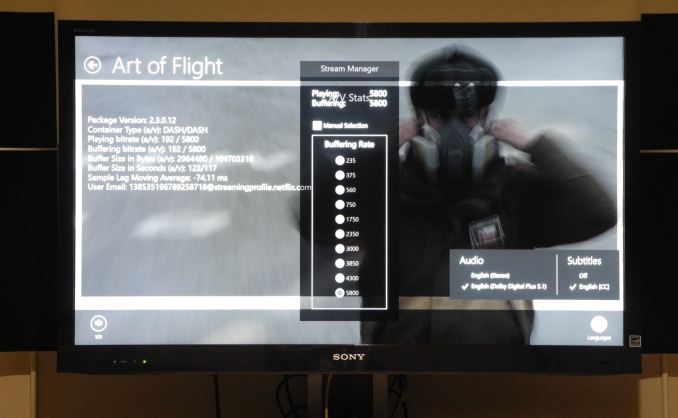The NVIDIA GeForce GTX 750 Ti and GTX 750 Review: Maxwell Makes Its Move
by Ryan Smith & Ganesh T S on February 18, 2014 9:00 AM ESTHTPC Aspects : Network Streaming Performance
Windows 7-based HTPCs need hardware acceleration in both Adobe Flash and Microsoft Silverlight for optimal streaming performance with YouTube and Netflix. The move to Windows 8.1 has made Silverlight unnecessary. The Netflix app on Windows 8.x brings a HTPC's capability on par with dedicated streaming consoles, with support for Super HD (6 Mbps) streams as well as Dolby Digital Plus bitstreaming support. The latest app also renders the video in such a way as to make taking screenshots an exercise in frustration.
As the above photograph shows, the Netflix app can be set to bitstream Dolby Digital Plus to the AV receiver and the 750Ti supports it. The video and audio streams are at 5.8 Mbps and 192 kbps respectively. It is not immediately evident as to whether GPU acceleration is being utilized. However, tracking the GPU / VPU loading and PC power consumption numbers make it obvious that it is not software decode at work in the Netflix app.
Unlike Silverlight, Adobe Flash continues to maintain some relevance right now. YouTube continues to use Adobe Flash to serve FLV (at SD resolutions) and MP4 (at both SD and HD resolutions) streams. YouTube's debug OSD indicates whether hardware acceleration is being used or not.
Similar to our Netflix streaming test, we recorded GPU / VPU loading as well as power consumption at the wall when streaming the 1080p version of the sample YouTube clip. The table below presents the relevant numbers for various configurations and streaming services.
| Streaming Video Performance | ||||||
| Netflix | YouTube | |||||
| GPU/VPU Load | Power | GPU/VPU Load | Power | |||
| NVIDIA GeForce GTX 750 Ti | 11.95/12.65% | 56.44 W | 16.26/15.74% | 55.45 W | ||
| NVIDIA GeForce GT 640 | 5.99/25.80% | 58.89 W | 15.57/25.72% | 58.93 W | ||
| AMD Radeon HD 7750 | 0.72% | 66.79 W | 3.57% | 67.11 W | ||
NVIDIA has been touting Maxwell's low power nature, and it proves to be the best of the three candidates in terms of power efficiency when it comes to GPU support for streaming services.












177 Comments
View All Comments
Mondozai - Wednesday, February 19, 2014 - link
USA in recession? You are either ignorant or use your own home-cooked economics for "special" people like yourself.As for consoles. Sure you can get low-end cards for cheaper sums a PC but people buy consoles for their games, simplicity and the fact that they are increasingly multimedia machines for a low cost.
These factors will not change with these new cards.
Yojimbo - Wednesday, February 19, 2014 - link
I thought I remember reading a headline a while back that said Sony or Microsoft or both were not planning on selling their hardware for a loss this time...madmilk - Tuesday, February 18, 2014 - link
The launch PS3 cost over $800 to manufacture, and Sony lost something like $3 billion in the first two years from hardware sales even though the PS3 wasn't even selling that well. To a lesser extent, Microsoft had the same problem with the Xbox 360. Of course Sony and Microsoft would go for cheaper, mid-range off-the-shelf components this time around. No one wants to make the same mistake twice.Antronman - Tuesday, February 18, 2014 - link
Wow. What do they think, everybody here is an OC pro who has/had world records and has a monster closed loop browsing/gaming/work setup? I don't give a damn about lower power consumption if it means I have to OC the balls off the card!moozoo - Tuesday, February 18, 2014 - link
Please include at least one fp64 benchmark in the compute section.It is great that you found out and reported the fp64 ratio.
Its a pity there isn't at least one low power low profile card with good DP Gflops (at least enough to beat the CPU and form a compelling argument to switch API's)
At work we only get small form factor PCs, and asking for anything that looks different ends in politics.
Ryan Smith - Thursday, February 20, 2014 - link
For the moment FP64 data is available via Bench. This being a mainstream consumer card, it's purposely not built for high FP64 performance; FP64 is there for compatibility purposes rather than being able to do much in the way of useful work.This is a purposeful market segmentation move that won't be going anywhere. So cards such as the 750 Ti will always be very slow at FP64.
jrs77 - Tuesday, February 18, 2014 - link
Now we need a manufacturer to release a GTX750 with single-slot cooler.koolanceGamer - Tuesday, February 18, 2014 - link
While all of this "low power" stuff is a little boring to me (not that anything is really pushing the high end card) I hope that in the not too distant future even the video cards like the 780/Titan will be able to be powered by the PCI alone.I would love to do a gaming build with a PCI based SSD and no cables coming off the video cards, it would be so clean!
EdgeOfDetroit - Tuesday, February 18, 2014 - link
Well I want laser light circuit cables. So much faster than copper and they would look so clean, you wouldn't even know there was a cable there unless you put your hand into the laser beams to see the pretty lights...... Ahh crap another BSOD, these laser cables suck!
Devo2007 - Wednesday, February 19, 2014 - link
Starting to wonder what a good card to replace a GTX 560 Ti would be (that's still relatively affordable). Would I have to step up to something like the R9 270 or GTX 760 cards to make things worthwhile? The power savings of the GTX 750 Ti aren't really a big factor as I'm currently using a 650w PSU, but I also don't want to spend a ton of money.